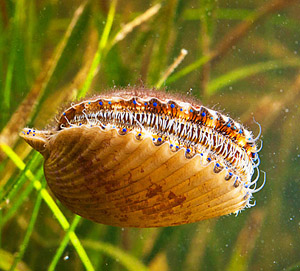Bay Scallop recovery efforts in the waters off Charlotte County will be getting a much needed boost on Sunday, Dec. 16 when 8 million young scallop larvae are released into local waters.
The release is being spearheaded by Florida Sea Grant agent Betty Staugler, Charlotte County, with assistance from area volunteers, the Florida Fish and Wildlife Conservation Commission, and Bay Shellfish Company, and funding support from the West Coast Inland Navigation District.
This is the first of what will likely take many more restoration efforts to restore a bay scallop fishery that collapsed some 30 years ago due to water quality issues, loss of seagrass beds and overharvesting. Today, water quality and seagrass conditions appear to have improved enough to again support these fragile creatures.
The Florida bay scallop is a bivalve mollusk that grows and lives in seagrass beds in relatively shallow coastal water, 4 to 10 feet deep. At one time bay scallops could be found from Palm Beach to Pensacola, and supported both recreational and commercial fisheries in Florida. Today, consistently healthy populations can only be found in selected locations along Florida’s Big Bend, north of Weeki Wachee to Port St. Joe.
Bay scallops live the majority of their very short lives in shallow water seagrass meadows. They live just 12 to 18 months and prefer high salinity water. They also require good water quality conditions. Each fall adult bay scallops reproduce, sending millions of tiny eggs into the water column. Fertilized eggs become floating larvae within 36 hours. After another two weeks they become tiny spat and settle out on seagrass blades. From here, they develop their shell and eventually drop into the seagrass beds for protection, remaining there the rest of their short lives.
This larval release is made possible through a collection effort that began earlier this summer, shortly after the conclusion of the all-volunteer Great Scallop Search sponsored by Sea Grant in Charlotte and Lee counties. Approximately 70 adult bay scallops were collected from a protected spawning area in August then transported to a commercial aquaculture firm where they could spawn in closely watched conditions.
By spawning them in the hatchery and raising them to a stage where they are ready to settle out on the seagrass blades, they are past the free floating stage which is their most vulnerable period.
 The bay scallop larval release taking place in Charlotte County is being coordinated with other releases occurring elsewhere in southwest Florida.
The bay scallop larval release taking place in Charlotte County is being coordinated with other releases occurring elsewhere in southwest Florida.
This is just one step in an ongoing partnership with organizations such as the National Estuary Programs, Mote Marine Laboratory, Charlotte and Sarasota County Governments, Sarasota BayWatch and those previously mentioned to restore the region’s Florida bay scallop populations
Volunteer opportunities exist for the public to assist in evaluating bay scallop populations in August of each year. Now in its fifth year, the Great Bay Scallop Search is a no-harvest citizen science event, designed to document the health and status of the bay scallop population in our local waters.
Volunteers have really rallied around, and in many regards, helped drive the restoration efforts of this charismatic little species with tiny blue eyes.
For more information on scallop restoration efforts in Charlotte County, e-mail Betty Staugler.




